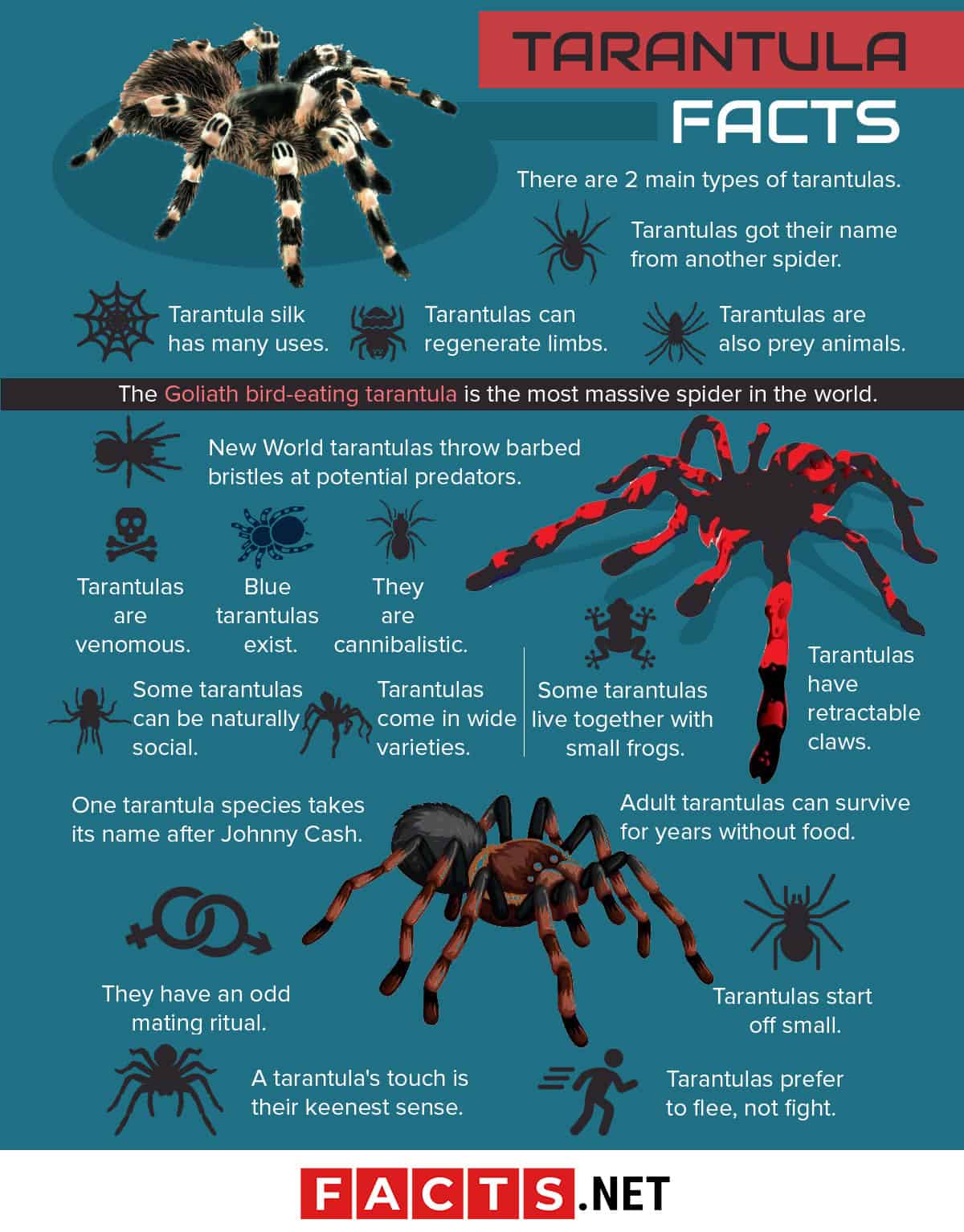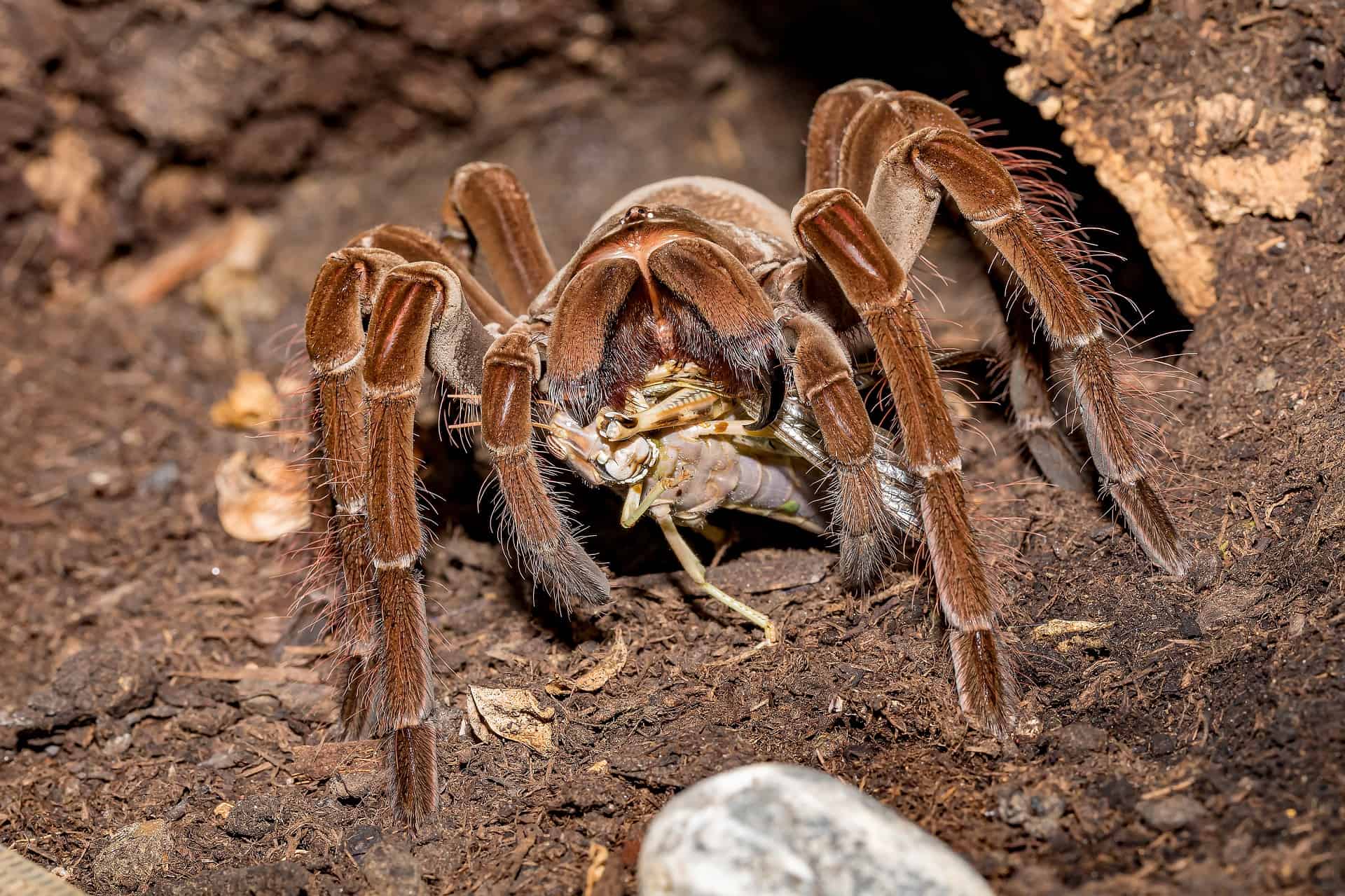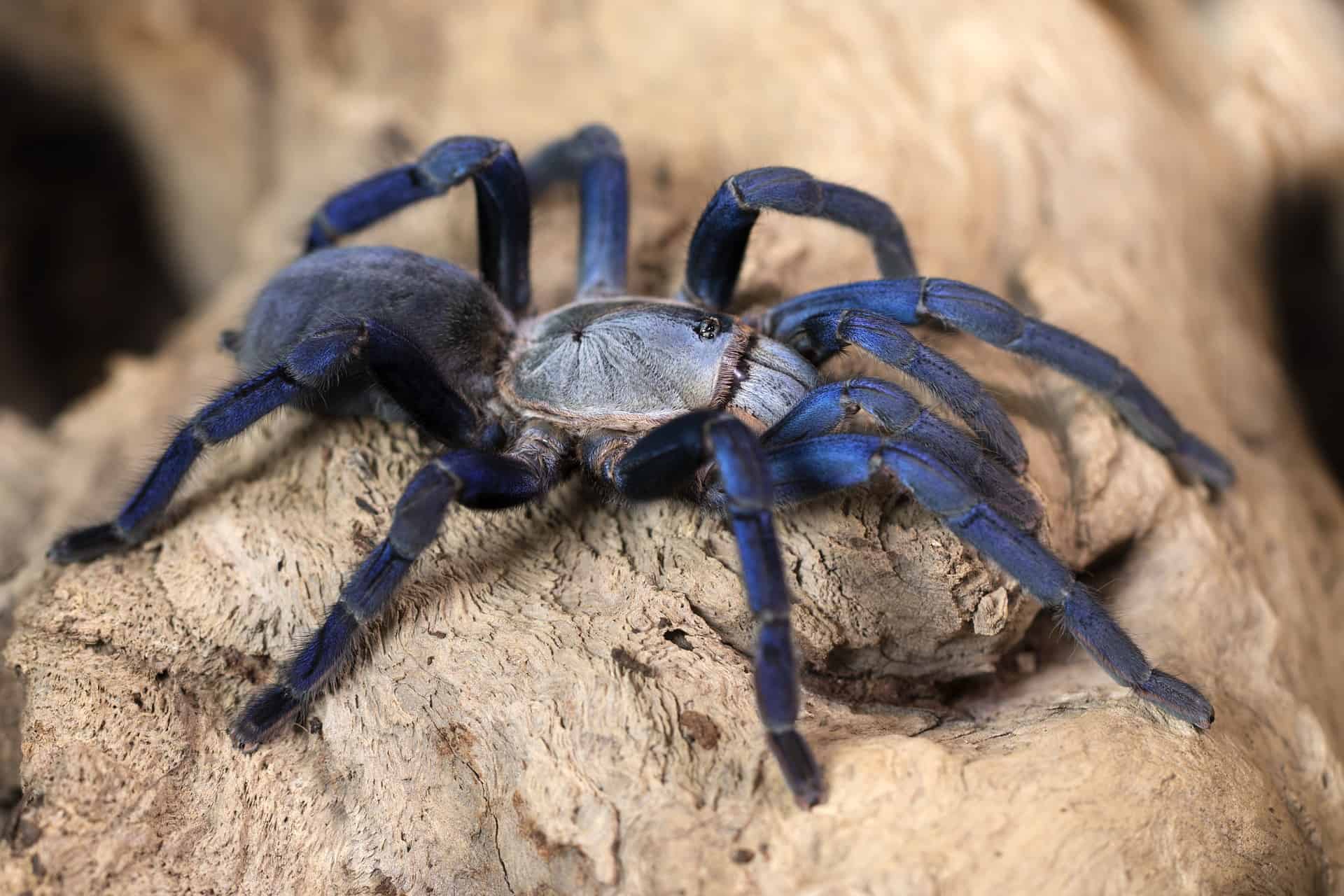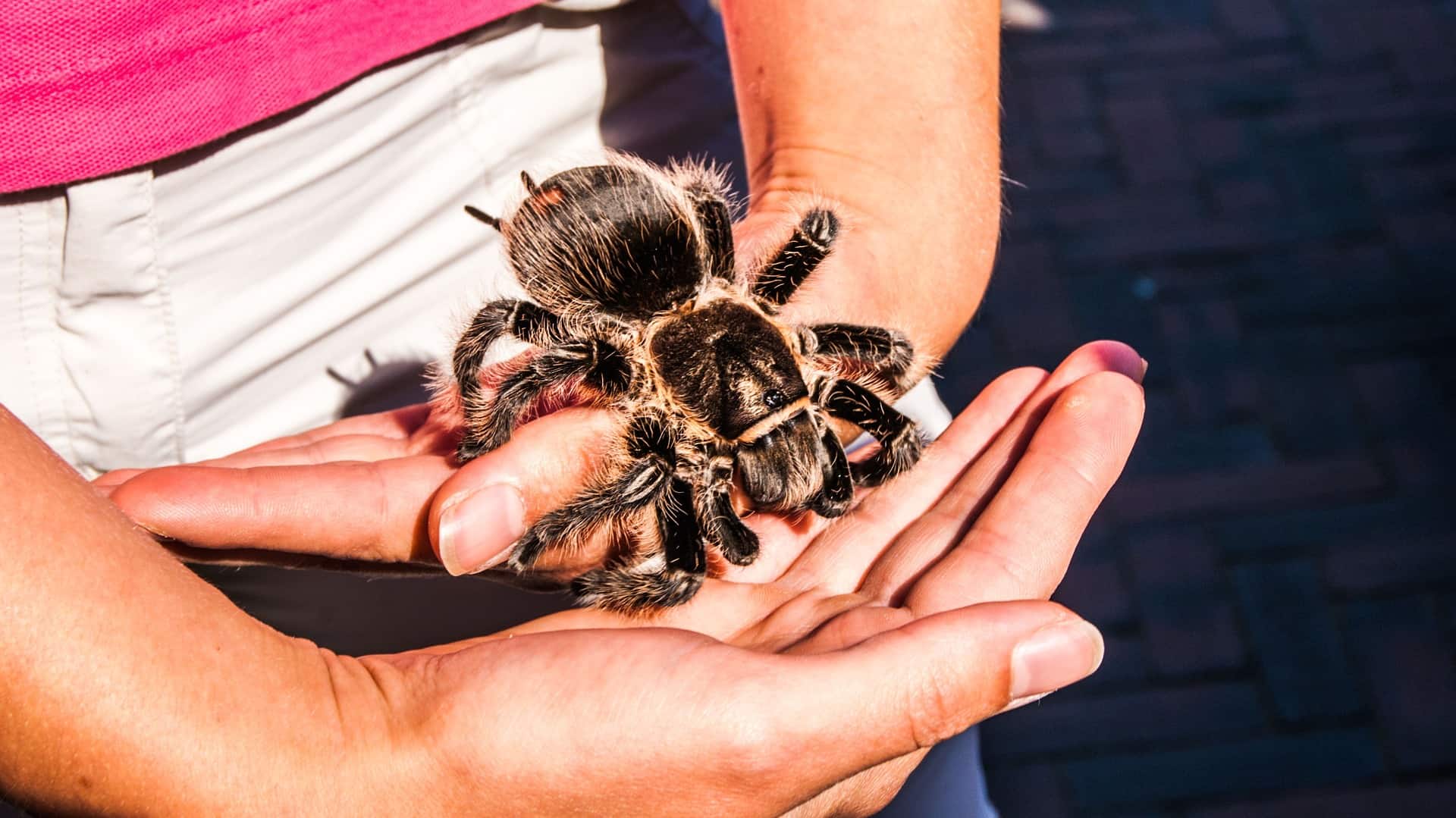
Tarantulas are some of the biggest spiders on Earth. With their popularity in thriller films and TV shows, people find these big and hairy spiders scary and intriguing. With some tarantula species now widely available as exotic pets, we’re beginning to know more about these mysterious animals. What better way to learn more about them than with these thrilling tarantula facts?
- Female tarantulas only mate once a year.
- There are around 900-1,000 known species of tarantulas.
- Females can live up to 30 years, while males typically only live around 7 years.
- They also have four pairs of legs with seven segments each.
- They typically reach maturity at around 2-5 years of age.
- Tarantulas belong to the family Theraphosidae.
- Tarantulas live on every continent except Antarctica.
- Like other spiders, they have two main body parts: the prosoma (cephalothorax) and the opisthosoma (abdomen).
- Their exoskeleton supports their muscles and protects their organs.
- Most tarantulas have the element “pelma” in their genus names.
- As spiders, tarantulas are more related to scorpions and horseshoe crabs than they are to insects.
- Tarantulas prefer warmer areas.
- They are mostly nocturnal.
- Tarantulas live in burrows.
- They are ambush predators.
- Instead of blood, tarantulas use hemolymph for oxygen and nutrient transport.
- They grow through molting, or shedding their exoskeletons.
- Male tarantulas often have smaller bodies but longer legs than females.
- Some tarantula species can take up to 10 years to reach sexual maturity.
- They catch prey by pouncing on them and piercing them with fangs.
Tarantula Facts Infographics

The Goliath bird-eating tarantula is the most massive spider in the world.

While it only comes second to the giant huntsman spider as the largest spider in the world by leg span, the Goliath birdeater (or Goliath bird-eating tarantula) is the world’s largest spider by mass. Goliath birdeaters (Theraphosa blondi) live in the rainforests of South America.
These huge tarantula spiders can reach up to one foot (30 cm) in leg span, which is as big as a large dinner plate. Their bodies alone can be as big as a large fist. They also can weigh up to 6 oz (170 grams), as heavy as a young puppy.
Despite having a name like the “Goliath birdeater”, they are ground-dwelling spiders and very rarely eat birds. They can, however, eat small mammals, frogs, or even snakes. Their fangs are large enough to do considerable damage to large prey. The fangs of a Goliath bird-eating tarantula can reach up to 0.79-1.57 in (2-4 cm) in length.
Tarantulas got their name from another spider.
The original “tarantula” is ironically not part of the tarantula family. This spider is Lycosa tarantula, which experts now refer to as the tarantula wolf spider. The name originates from the Italian town Taranto, where the tarantula wolf spider often lives. The term tarantula then applied to any unknown ground-dwelling spider, including what we now consider true tarantulas.
Tarantula silk has many uses.
Aside from their 8 legs, spiders are best known for making intricate webs that allow them to trap prey. However, tarantulas don’t actually make webs. Instead, they use their silk for other purposes. Since most tarantulas live underground, tarantulas usually line their burrows with their silk to make the ground more stable. Additionally, some may line the areas surrounding their burrows with silk to warn them of approaching predators and prey.
Tarantula silk is also useful for reproduction. To prepare for mating, a male tarantula makes a “sperm web,” or a tent-like web that stores his sperm. Females, on the other hand, spin silk around their egg cases to provide an extra layer of protection for the eggs. Interestingly, scientists have also noted that tarantulas can produce silk from their feet. This makes them unique, since most spiders can only produce silk from their spinnerets and silk glands. How’s that for some thrilling tarantula facts?
Tarantulas can regenerate limbs.
When a young tarantula loses a leg, it generally is no big deal. It may even eat the severed leg to get some nutrition out of it. This is because the tarantula can regrow that leg as it molts. While the newly-regenerated leg will be smaller and will have fewer hairs than the other legs, it will look normal with a few more molts.
Tarantulas have retractable claws.
Like other types of spiders, tarantulas can climb trees and even smooth walls without breaking a sweat. They owe their amazing grip to the claws at the end of their legs. At the end of each leg, tarantulas have two to three retractable claws, somewhat like a cat’s claw. Fine bristles, or scopula, surround these claws. The claws and the scopula allow them to scale even smooth surfaces, such as glass.
Tarantulas are also prey animals.
While they may be large, fearsome predators that look tough and menacing, tarantulas fall prey to many other animals. Larger birds, snakes, frogs, centipedes, and mammals can hunt and feed on tarantulas. However, the most well-known predator that feeds primarily on tarantulas is the tarantula hawk wasp.
The tarantula hawk wasps track tarantulas through smell, attacking them with a powerful sting once they locate them. Since tarantula hawk wasps have venomous stingers, they can paralyze large tarantulas. The tarantula hawks then drag the paralyzed spiders to their nests and consequently lay an egg inside the spider’s abdomen. After this, it leaves to find another spider. When the egg hatches, the larva feeds on the tarantula and eventually grows into an adult tarantula hawk. Definitely one of the scarier tarantula facts.
There are two main types of tarantulas.
There are two major types of tarantulas: Old World tarantulas and New World tarantulas. Old World tarantulas come from Africa, Asia, and Europe. They are typically much faster and more aggressive. Some examples are the king baboon tarantula, cobalt blue tarantula, and the orange baboon tarantula.
Meanwhile, New World tarantulas come from the Americas. New World species are noticeably hairier and more docile than their Old World counterparts. Common examples of New World tarantulas are the Goliath bird-eating tarantula, Chilean rose hair tarantula, and the popular Mexican red-knee tarantula.
New World tarantulas throw barbed bristles at potential predators.
Although New World tarantulas are less likely to bite than Old World species, they evolved with a different defense mechanism to ward off would-be attackers. When they feel threatened, they launch irritating, hair-like bristles called setae from their abdomens. These sharp setae can cause a nasty itch and serious rashes in mild cases. For more serious cases, they can trigger allergic reactions or cause blindness when thrown at the predator’s eyes.
Some tarantulas live together with small frogs.
The Colombian lesserblack tarantula (Xenesthis immanis) often lives with an unlikely ally: the small dotted humming frog (Chiasmocleis ventrimaculata). They share the same burrow and have either a mutualistic or commensal relationship. The tarantula offers some protection against the frog’s natural predators, as well as some leftover food. The frog, on the other hand, protects the tarantula’s nest against ants.
Tarantulas are venomous.
Almost all spiders are venomous, and tarantulas are no exception. Despite their huge appearance, however, most tarantulas have venom comparable to a bee or wasp sting. The potency of tarantula venom varies widely from species to species. Generally, Old World species lack the defensive bristles of New World species, so they are more likely to bite out of defense with more potent venom.
While their bites can cause some discomfort for a few days, the venom is not significant enough to warrant immediate medical attention. Like bee stings, however, the venom can trigger fatal allergic reactions in some people. Certainly one of the more important tarantula facts to take note of.
Tarantulas come in wide varieties.
With over 850 known species, tarantulas vary widely in colors, sizes, and habitats. Their colors and markings differ vastly, ranging from shades of green, pink, red, or blue. However, most North American species are brown. Tarantula varieties can also be classified as tree-dwelling or ground-dwelling species.
Blue tarantulas exist.
Blue is a rare color in animals, but tarantulas adopted the color at least eight times over their genetic history. While a number of tarantulas come in blue, none of these species appear to be closely related. Similarly, it does not appear to be a result of sexual selection. To this day, scientists still don’t know why some tarantulas evolved to be blue.

They are cannibalistic.
As any owner of a pet tarantula would know, they should not be kept in groups or even pairs. Known for their cannibalistic tendencies, tarantulas will normally attempt to eat each other. This behavior has also been observed in tarantula mating, with females often attempting to eat the male.
Some tarantulas can be naturally social.
Although the vast majority of tarantulas are territorial and will attempt to eat any other spider that wanders too close to their burrows, some species can get along with their neighbors just fine. These communal tarantula spiders are often arboreal species that naturally live in the same tree as other tarantulas. If they don’t have a sufficient food source, however, they may try to eat each other as well.
One tarantula species takes its name after Johnny Cash.
The Aphonopelma johnnycashi is a species of tarantula that takes its name after country singer Johnny Cash. People discovered the tarantula in Folsom State Prison, which Johnny Cash sang about in his song, Folsom Prison Blues. The mature male tarantulas of this species typically come in black, coinciding with Johnny Cash’s reputation as the “Man in Black”.
Adult tarantulas can survive for years without food.
With their efficient digestive system, tarantulas can last a very long time without eating. For some tarantula species, adults can survive up to two years as long as they have water available. Generally, younger tarantulas can survive for weeks and months without eating as well.
They have an odd mating ritual.
After depositing sperm on his silken sperm web, a male tarantula collects the sperm using arm-like limbs called pedipalps. He then begins searching for a female by tracking her scent and silk. When he finds a female’s burrow, the male tarantula taps the ground to let the female know that he’s there.
If the female tarantula wants to mate, the male initiates the courtship ritual by “dancing”. Through this display, a male lowers his head, shows his abdomen and shake his pedipalps. Male tarantulas may also drum on the female’s silk. In turn, an uninterested female will either ignore him or try to attack him.
Once a female agrees to mate, the male places his sperm packets into the female’s genital openings. Some male tarantulas have specialized hooks at the tip of their front legs to prevent the female from biting them. Once the mating is successful, the male will try to escape as females tend to feed on them after the process.
A tarantula's touch is their keenest sense.
The fine bristles, or setae, that coat their bodies contribute to a tarantula’s strong sense of touch. Tarantulas use these setae to sense vibrations, wind changes, and chemical signatures to detect and evade threats.
Tarantulas prefer to flee, not fight.
One of the key tarantula facts to know about is that they will not bite if they don’t have to. When they feel threatened, tarantulas are more likely to run and hide. While tarantulas can bite and get aggressive, they would rather use their long fangs as a last resort.
Tarantulas will often only bite when they feel cornered. They typically display a threat posture as a warning before they bite, where they raise their front legs and bare their fangs.
Tarantula fangs face downwards.
The chelicerae or mouthparts of tarantulas contain the venom glands and have hard and hollow fangs at the tips. Unlike the fangs of most spiders that meet horizontally from each side, tarantulas have downward-facing fangs. In line with this, they move up and down instead of side-to-side.
Various species of tarantulas are kept as pets.
The big, colorful bodies of tarantulas may frighten most people, but they do have their charm. In areas that allow it, exotic pet enthusiasts may opt for tarantulas as pets. While more common species are docile, it would not be a good idea to cuddle with a pet tarantula.

They are a delicacy in some parts of the world.
In certain parts of the world, people hunt tarantulas to eat them. One well-known dish is the fried spider, which is a regional delicacy in Cambodia. Fried spiders consist of the tarantula species Cyriopagopus albostriatus, or Thailand Zebra Leg tarantula. People either farm or hunt the tarantulas for human consumption.
Some tarantula species are in danger of extinction.
Due to human hunting, capturing for pet trade, or habitat destruction, various tarantulas face the threat of extinction in the wild. The Gooty sapphire ornamental tarantula, for example, is a critically endangered tarantula species. This blue tarantula lives in a small deciduous forest in India, which has slowly declined over the years due to illegal logging.
Tarantulas don’t have good eyesight.
Tarantulas may have eight eyes, but most tarantulas have poor eyesight. Compared to other species that can perceive images, tarantulas can only detect light, darkness, and movement. Interestingly, scientists report that tree-dwelling species have better eyesight than ground-dwelling tarantulas.
Tarantulas start off small.
Adult tarantulas may grow up to the size of a dinner plate, but they all start small and vulnerable. A baby tarantula or spiderling starts off less than 0.4 inches (1 cm) long, coming out of an egg sac along with its other siblings.
Female tarantulas lay egg sacs that can hold 50-2,000 individual eggs. The mothers guard the egg sacs for about 6-8 weeks and regularly turn them to prevent the eggs from deforming.
Female tarantulas can keep growing after reaching maturity.
While male tarantulas typically die shortly after reaching sexual maturity, female tarantulas can keep growing. Females live longer than males, periodically molting until the end of their lives. Males who attempt to molt after reaching maturity will often get stuck in their exoskeletons and die in the process. Definitely one of the more unfortunate tarantula facts.
They run faster when it’s hot.
Instead of muscles, tarantulas use a liquid called hemolymph to move around. Hydraulic pressures move this liquid back and forth, creating a flexing and extending motion in their legs. Temperature affects the physical properties of this hemolymph, and consequently affects the spiders’ leg movements. Through a series of experiments, scientists discovered that tarantulas run faster in warmer temperatures.
Drops can be deadly for a tarantula.
Although tarantulas can climb vertical walls, falling can be fatal for them. For tarantulas, it’s true that the bigger they are, the harder they fall. More aptly, the heavier they are, the harder they fall. Since they have heavier bodies, they fall to the ground with a much harder force than other spiders. If they fall from a great height, they will likely rupture their exoskeletons and die.
Male tarantulas travel more than females.
If you see a tarantula wandering around the forest or desert floors, it’s more likely to be a male. Male tarantulas travel long distances to look for potential mates, particularly in the warmer months or after rainstorms. Female tarantulas, on the other hand, tend to stay in their burrows and lie in wait for males to discover them.
Some types of tarantulas produce sounds.
Most tarantulas are quiet, but some species will make their presence known through sounds. Such is the case for the Queensland hissing tarantula, or the so-called “barking spider”. Native to Queensland, Australia, these spiders produce whistling, hissing, or barking sounds by rubbing its mouthparts together.
The setae in the mouthparts produce vibrations that come in the form of sound. These tarantulas make these sounds to ward off potential threats.
Was this page helpful?
Our commitment to delivering trustworthy and engaging content is at the heart of what we do. Each fact on our site is contributed by real users like you, bringing a wealth of diverse insights and information. To ensure the highest standards of accuracy and reliability, our dedicated editors meticulously review each submission. This process guarantees that the facts we share are not only fascinating but also credible. Trust in our commitment to quality and authenticity as you explore and learn with us.
